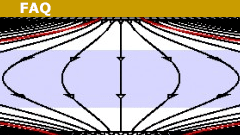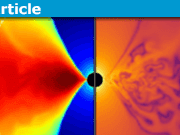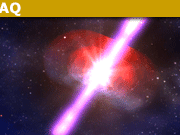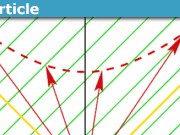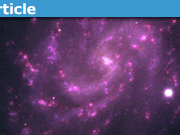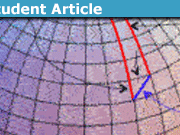What Is the Steady-state Model and Why It’s No Longer Viable
[Back in 2011, I wrote a FAQ entry for physicsforums on the steady state model and why it is no longer viable. I’ve learned more about the theory since then, and it turns out that Fred Hoyle was a lot cleverer than I’d assumed. The following is an update to that FAQ that, while more technical, is also more technically correct. This is a slightly abridged version of the description given in section 8.4 of my GR book.]
From 1948 until around the mid-1960s, the Big Bang theory had viable competition in the form of the steady-state model, originated by the British trio of Fred Hoyle, Hermann Bondi, and Thomas Gold. Legend has it that they came up with the idea after seeing a horror movie called Dead of Night, in which events from the beginning of the story repeat themselves later. This led them to imagine that the universe could, although expanding, remain locally in the same state at all times. If this were to happen, the empty space being opened up between the galaxies would have to be filled back in by the spontaneous creation of matter, assumed to be hydrogen atoms. The model holds a strong philosophical appeal because it generalizes the Copernican principle so that it applies not just to conditions everywhere in space but also at all times.
They published the idea in a pair of back-to-back papers, one by Bondi and Gold[Bondi 1948] and one by Hoyle,[Hoyle 1948] with comments appended to the former on the differences between the two approaches. The Bondi-Gold paper is especially fun to read, because it is written in nontechnical language and shows a type of daring and creative science that is not often encountered today. Much of it reads like a catalog of cherished principles of physics that were to be given up, including Lorentz invariance, general relativity, the equivalence principle, and possibly the laws of conservation of charge and mass-energy. The following is a brief presentation (in slightly different notation) of the Hoyle’s more mathematically detailed ideas, as sketched in his original paper. Although Hoyle eventually fleshed out the ideas more thoroughly, by the time he had done so the steady-state theory was already on its way to being crushed under the weight of contrary observations.
Since the model is always to be in the same state, the universe’s rate of expansion must always be the same, i.e., the Hubble constant really is a constant over time. This requires exponential growth, which means that the geometry is that of de Sitter space. In any model that assigns an infinite age to the universe, one must explain why the universe has not undergone heat death due to the second law of thermodynamics. The steady-state model successfully addresses this problem, because the exponential expansion is rapid enough to prevent thermal equilibrium from happening.
Hoyle sets out to preserve local conservation of energy-momentum, without which the Einstein field equations become inconsistent. (This was Hoyle’s more conservative approach. Bondi and Gold advocated replacing general relativity completely rather than modifying it.) He postulates a massless, chargeless, scalar field C, called the “C field,” the letter “C” standing for “creation.” Suppose that the C field’s contribution to the stress-energy tensor ends up being that of a perfect fluid with the same rest frame as the ordinary matter. We need this to result in local conservation of energy-momentum, i.e., a zero divergence for the stress-energy tensor, and a simple calculation using the Einstein field equations shows that this requires that it have ##\rho+P=0##, just like a cosmological constant. Since the ordinary matter has ##\rho>0## and ##P>0##, the C field will either need to contribute negative energy density or negative pressure. We’ll see below that Hoyle’s model is constructed so that the C field has zero energy and negative pressure. One will often see the C field described incorrectly as having negative energy to cancel out the positive energy of the matter being created. That wouldn’t have worked, because then the total energy density ##\rho## would always be zero, which is not what we observe. (We can verify the nonzero value of ##\rho##, for example, from the Friedmann equations and comparison with observation.)
To understand more about why the theory took the form it did, it is helpful to look at some general physical considerations about symmetry. As Bondi and Gold admit candidly, any theory of this type is likely to violate Lorentz invariance. We can observe an evacuated box and wait for hydrogen atoms to appear. When they appear, they’re in some state of motion, at least on the average. This state of motion defines a preferred frame. In addition to breaking symmetry under Lorentz transformations, the theory lacks time-reversal invariance (because matter appears but never disappears) and charge-conjugation symmetry (because matter appears but antimatter doesn’t). All of these asymmetries arise because in this approach, we try to explain the observed asymmetries of the cosmological state of the universe as arising directly from asymmetries in the underlying local laws of physics. Such an approach is very different from the modern one, in which we expect the asymmetries to arise from either boundary conditions or instabilities (spontaneous symmetry breaking).
Because the C field is massless and chargeless, we would normally expect it to obey the wave equation ##\nabla_a\nabla^a C=0##. Hoyle’s field does not, however, evolve according to any Lorentz-invariant dynamical law. Instead it simply evolves as C=t, where t is a preferred time coordinate. In any cosmological model in which the matter fields are modeled as perfect fluids, we have a preferred time coordinate which is the proper time of an observer at rest with respect to the fluid, and in the Hoyle model we do assume that this is the time t we should use in defining C. However, Hoyle’s theory is different because it gives this preferred time a role in the local laws of physics, thereby breaking Lorentz invariance.
The value of the scalar field C cannot have any directly observable effects, since then its time-evolution would distinguish one epoch of the universe from another. Instead we form the gradient ##\nabla_a C##. This gives a vector, which can be interpreted as a velocity four-vector defining the preferred frame of reference. An observer in this frame is at rest relative to the local cosmological fluid, observes the universe to be homogeneous, and also observes that when new atoms are created from the vacuum, they are on the average at rest.
Like the cosmological constant, the C field is taken to be a universally prescribed property of the vacuum. There is a difference, however, because the cosmological constant’s contribution to the stress-energy is proportional to the metric, which preserves the equivalence principle. As remarked at the end of the Bondi-Gold paper, the C field violates the equivalence principle. No calculation is spelled out, but they say based on a personal communication from Hoyle that the field exerts a force on matter which produces a significant acceleration in an atom, but a negligible one in a star.
A claimed selling point of the C field was that it would prevent the formation of singularities, including both a Big Bang singularity and black holes. This is reasonable, since the C field violates the null and strong energy conditions, and the Hawking-Penrose singularity theorems depend on these conditions.
The steady-state model began to succumb to contrary evidence when Ryle and coworkers counted radio sources and found that they did not show the statistical behavior predicted by the model. The coup de grace came with the discovery of the cosmic microwave background, which demonstrated directly that the universe had once been much hotter than it is now. Attempts have been made to produce variations on the model that are consistent with these observations, but they have not succeeded; for a detailed discussion see Wright 2015.
Bondi and Gold, “The Steady-State Theory of the Expanding Universe,” MNRAS 108 (1948) 252; http://adsabs.harvard.edu/cgi-bin/nph-bib_query?bibcode=1948MNRAS.108..252B
Hoyle, “A New Model for the Expanding Universe,” MNRAS 108 (1948) 372, http://adsabs.harvard.edu/cgi-bin/nph-bib_query?bibcode=1948MNRAS.108..372H
Wright, “Errors in the Steady State and Quasi-SS Models,” http://www.astro.ucla.edu/~wright/stdystat.htm”>http://www.astro.ucla.edu/~wright/stdystat.htm
Commenting is disabled for this FAQ
PhD in physics. I teach physics at Fullerton College, a community college in Southern California. I enjoy writing, playing viola, brewing beer, climbing and mountaineering.

